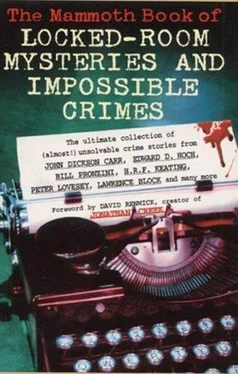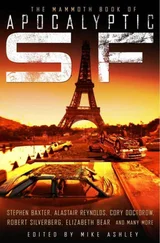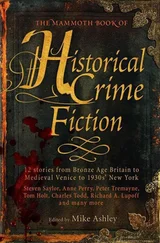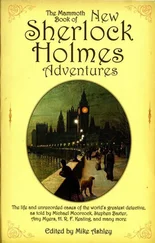Mike Ashley - The Mammoth Book of Locked-Room Mysteries And Impossible Crimes
Здесь есть возможность читать онлайн «Mike Ashley - The Mammoth Book of Locked-Room Mysteries And Impossible Crimes» весь текст электронной книги совершенно бесплатно (целиком полную версию без сокращений). В некоторых случаях можно слушать аудио, скачать через торрент в формате fb2 и присутствует краткое содержание. Жанр: Детектив, на английском языке. Описание произведения, (предисловие) а так же отзывы посетителей доступны на портале библиотеки ЛибКат.
- Название:The Mammoth Book of Locked-Room Mysteries And Impossible Crimes
- Автор:
- Жанр:
- Год:неизвестен
- ISBN:нет данных
- Рейтинг книги:3 / 5. Голосов: 1
-
Избранное:Добавить в избранное
- Отзывы:
-
Ваша оценка:
- 60
- 1
- 2
- 3
- 4
- 5
The Mammoth Book of Locked-Room Mysteries And Impossible Crimes: краткое содержание, описание и аннотация
Предлагаем к чтению аннотацию, описание, краткое содержание или предисловие (зависит от того, что написал сам автор книги «The Mammoth Book of Locked-Room Mysteries And Impossible Crimes»). Если вы не нашли необходимую информацию о книге — напишите в комментариях, мы постараемся отыскать её.
A new anthology of twenty-nine short stories features an array of baffling locked-room mysteries by Michael Collins, Bill Pronzini, Susanna Gregory, H. R. F. Keating, Peter Lovesey, Kate Ellis, and Lawrence Block, among others.
The Mammoth Book of Locked-Room Mysteries And Impossible Crimes — читать онлайн бесплатно полную книгу (весь текст) целиком
Ниже представлен текст книги, разбитый по страницам. Система сохранения места последней прочитанной страницы, позволяет с удобством читать онлайн бесплатно книгу «The Mammoth Book of Locked-Room Mysteries And Impossible Crimes», без необходимости каждый раз заново искать на чём Вы остановились. Поставьте закладку, и сможете в любой момент перейти на страницу, на которой закончили чтение.
Интервал:
Закладка:
I remembered these eccentricities of Murray’s being mentioned in the article I had read about him. It had seemed to me then, judging from his quoted comments, that they were calculated in order to enhance his image as King of the Popular Culture Collectors. But if so, it no longer mattered; all that mattered now was that he was dead.
Eberhardt went on, “Three days ago Murray started acting a little strange. He seemed worried about something, but he wouldn’t discuss it with anybody; he did tell the housekeeper that he was trying to work out ‘a problem.’ According to both the niece and the housekeeper, he refused to see either his cousin or his brother during that time; and he also took to locking himself into each of his Rooms during the day and in his bedroom at night, something he had never done before.
“You can figure that as well as I can: he suspected that somebody wanted him dead, and he didn’t know how to cope with it. He was probably trying to buy time until he could figure out a way to deal with the situation.”
“Only time ran out on him,” I said.
“Yeah. What happened as far as we know it is this: the niece came home at twelve forty-five, went to talk to Murray about getting an advance on her allowance and didn’t get any answer when she knocked on the door to the Pulp Room. She got worried, she says, went outside and around back, looked in through the window and saw him lying on the floor. She called us right away.
“When we got here and broke down the door, we found Murray lying right where she told us. Like I said before, he’d been stabbed with a splinterlike piece of steel several inches long; the outer two inches had been wrapped with adhesive tape – a kind of handle grip, possibly. The weapon was still in the wound, buried around three inches deep.”
I said, “That’s not much penetration for a fatal wound.”
“No, but it was enough in Murray’s case. He was a scrawny man with a concave chest; there wasn’t any fat to help protect his vital organs. The weapon penetrated at an upward angle, and the point of it pierced his heart.”
I nodded and waited for him to go on.
“We didn’t find anything useful when we searched the room,” Eberhardt said. “There are two windows, but both of them are nailed shut because Murray was afraid somebody would open one of them, and the damp air off the ocean would damage the magazines; the windows hadn’t been tampered with. The door hadn’t been tampered with either. And there aren’t any secret panels or fireplaces with big chimneys or crap like that. Just a dead man alone in a locked room.”
“I’m beginning to see what you’re up against.”
“You’ve got a lot more to see yet,” he said. “Come on.”
He led me out into the hallway and down to the rear. I could still hear the sound of muted voices; otherwise the house was unnaturally still – or maybe my imagination made it seem that way.
“The coroner’s people have already taken the body,” Eberhardt said. “And the lab crew finished up half an hour ago. We’ll have the room to ourselves.”
We turned a corner into another corridor, and I saw a uniformed patrolman standing in front of a door that was a foot or so ajar; he moved aside silently as we approached. The door was a heavy oak job with a large, old-fashioned keyhole lock; the wood on the jamb where the bolt slides into a locking plate was splintered as a result of the forced entry. I let Eberhardt push the door inward and then followed him inside.
The room was large, rectangular – and virtually overflowing with plastic-bagged pulp and digest-sized magazines. Brightly coloured spines filled four walls of floor-to-ceiling bookshelves and two rows of library stacks. I had over 6,000 issues of detective and mystery pulps in my Pacific Heights flat, but the collection in this room made mine seem meager in comparison. There must have been at least 15,000 issues here, of every conceivable type of pulp and digest, arranged by category but in no other particular order: detective, mystery, horror, weird menace, adventure, Western, science fiction, air-war, hero, love. Then and later I saw what appeared to be complete runs of Black Mask, Dime Detective, Weird Tales, The Shadow and Western Story ; of Ellery Queen ’ s Mystery Magazine and Alfred Hitchcock ’ s Mystery Magazine and Manhunt ; and of titles I had never even heard of.
It was an awesome collection, and for a moment it captured all my attention. A collector like me doesn’t often see anything this overwhelming; in spite of the circumstances it presented a certain immediate distraction. Or it did until I focused on the wide stain of dried blood on the carpet near the back-wall shelves, and the chalk outline of a body which enclosed it.
An odd, queasy feeling came into my stomach; rooms where people have died violently have that effect on me. I looked away from the blood and tried to concentrate on the rest of the room. Like the Paperback Room we had been in previously, it contained nothing more in the way of furniture than an overstuffed chair, a reading lamp, a brass-trimmed rolltop desk set beneath one of the two windows and a desk chair that had been overturned. Between the chalk outline and the back-wall shelves there was a scattering of magazines which had evidently been pulled or knocked loose from three of the shelves; others were askew in place, tilted forward or backward, as if someone had stumbled or fallen against them.
And on the opposite side of the chalk outline, in a loosely arranged row, were two pulps and a digest, the digest sandwiched between the larger issues.
Eberhardt said, “Take a look at that row of three magazines over there.”
I crossed the room, noticing as I did so that all the scattered and shelves periodicals at the back wall were detective and mystery; the pulps were on the upper shelves and the digests on the lower ones. I stopped to one side of the three laid-out magazines and bent over to peer at them.
The first pulp was a 1930s and 1940s crime monthly called Clues. The digest was a short-lived title from the 1960s, Keyhole Mystery Magazine. And the second pulp was an issue of one of my particular favorites, Private Detective.
“Is this what you meant by a dying message?”
“That’s it,” he said. “And that’s why you’re here.”
I looked around again at the scattered magazines, the disarrayed shelves, the overturned chair. “How do you figure this part of it, Eb?”
“The same way you’re figuring it. Murray was stabbed somewhere on this side of the room. He reeled into that desk chair, knocked it over, then staggered away to those shelves. He must have known he was dying, that he didn’t have enough time or strength to get to the phone or to find paper and pencil to write out a message. But he had enough presence of mind to want to point some kind of finger at his killer. So while he was falling or after he fell he was able to drag those three magazines off their shelves; and before he died he managed to lay them out the way you see them. The question is, why those three particular magazines?”
“It seems obvious why the copy of Clues ,” I said.
“Sure. But what clues was he trying to leave us with Keyhole Mystery Magazine and Private Detective ? Was he trying to tell us how he was killed or who killed him? Or both? Or something else altogether?”
I sat on my heels, putting my back to the chalk outline and the dried blood, and peered more closely at the magazines. The issue of Clues was dated November 1937, featured a Violet McDade story by Cleve F. Adams and had three other, unfamiliar authors’ names on the cover. The illustration depicted four people shooting each other.
Читать дальшеИнтервал:
Закладка:
Похожие книги на «The Mammoth Book of Locked-Room Mysteries And Impossible Crimes»
Представляем Вашему вниманию похожие книги на «The Mammoth Book of Locked-Room Mysteries And Impossible Crimes» списком для выбора. Мы отобрали схожую по названию и смыслу литературу в надежде предоставить читателям больше вариантов отыскать новые, интересные, ещё непрочитанные произведения.
Обсуждение, отзывы о книге «The Mammoth Book of Locked-Room Mysteries And Impossible Crimes» и просто собственные мнения читателей. Оставьте ваши комментарии, напишите, что Вы думаете о произведении, его смысле или главных героях. Укажите что конкретно понравилось, а что нет, и почему Вы так считаете.










